Angela Ackerman's Blog: Writers Helping Writers
October 15, 2025
Win Editorial Feedback on Your First 10 Pages

Want to win editorial feedback and take your story opening from good to great?
Well, my writerly friend, you’re in luck! It’s time for our monthly Phenomenal First Pages contest. In this draw, you can win…
Editorial feedback on yourfirst 10 pages
Entering is easy. Leave your contact information on this entry form (or click the graphic below). If you win the draw, we’ll let you know how to send us your pages.
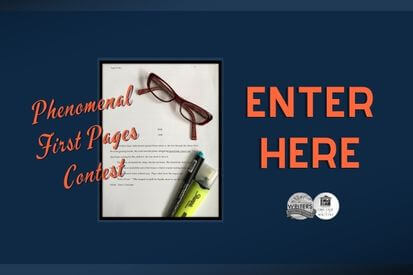 Contest DetailsThis is a 24-hour contest, so enter ASAP.Make sure your contact information on the
entry form
is correct. One winner will be drawn. If you win, we’ll email instructions for submitting your first 10 pages and synopsis.Please have your pages ready in case your name is selected. Format with 1-inch margins, double-spaced, and 12pt Times New Roman font. You���ll need to supply a synopsis (a rough one is fine) so Stuart has context for his feedback.The editor you’ll be working with: Stuart Wakefield
Contest DetailsThis is a 24-hour contest, so enter ASAP.Make sure your contact information on the
entry form
is correct. One winner will be drawn. If you win, we’ll email instructions for submitting your first 10 pages and synopsis.Please have your pages ready in case your name is selected. Format with 1-inch margins, double-spaced, and 12pt Times New Roman font. You���ll need to supply a synopsis (a rough one is fine) so Stuart has context for his feedback.The editor you’ll be working with: Stuart Wakefield

With 26 years of experience in theatre, broadcast media, and coaching, I���ve developed a deep love of character and what drives them. My coaching style is warm, thoughtful, and practical���I believe writing a book can be hard sometimes, but more often than not, it should be fun.
As an Author Accelerator Certified Book Coach, I specialize in story development, with a particular focus on character backstory and emotional depth. I���ve helped writers develop powerful, satisfying stories that hold up to editorial scrutiny���and two of my clients have books coming out this year.
I hold an MA in Professional Writing, and my most recent novel, Behind the Seams, reached the semifinals of the BookLife Fiction Prize Contest, scoring 10/10 in every category. I���ve also been commissioned to write a play, and my first TV show���based around celebrity characters���is available to stream online.
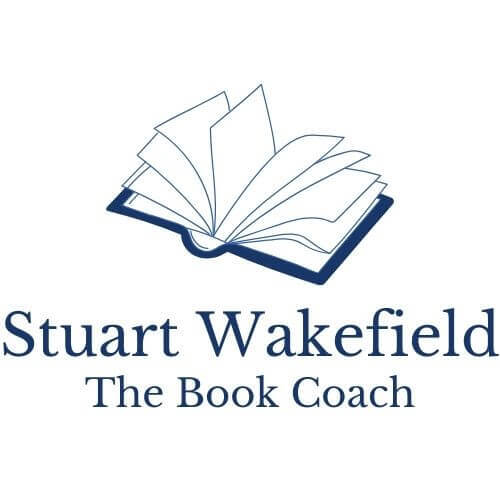
Grab my free ebook on emotional resilience for writers and learn more about my services at: https://www.thebookcoach.co/
I���m also the host of the podcast Master Fiction Writing, where I explore the craft of storytelling with writers, editors, and creatives from all walks of life.
Did you know…
Some winners find their dream editor through this contest, and a few have shared with us that their polished pages have helped them secure representation. Talk about phenomenal reasons to enter!
Sign Up for Notifications:
Every month is a new chance to win feedback. Subscribe to our blog in the sidebar, and notifications about this contest and other helpful writing articles will come right to your inbox.
Good luck, everyone. We can’t wait to see who wins!
PS: To amp up your first page, grab our First Pages checklist from One Stop for Writers. For more help with story opening elements, visit this Mother Lode of First Page Resources.
The post Win Editorial Feedback on Your First 10 Pages appeared first on WRITERS HELPING WRITERS��.
October 14, 2025
How to Tell the Difference Between a Hook and Inciting Incident
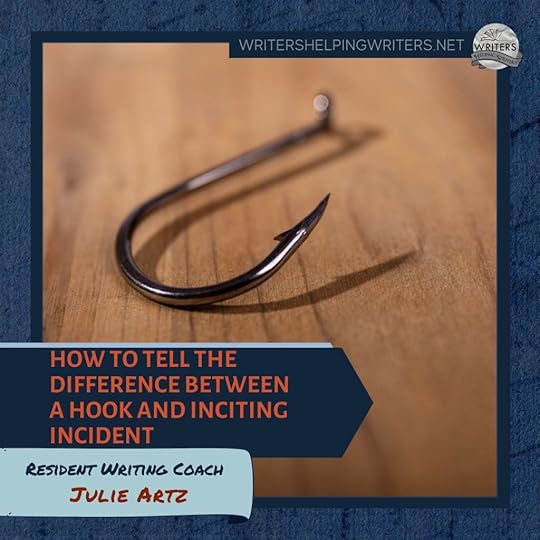
Opening pages are notoriously hard to get right, especially in early drafts of your manuscript. I���ve read hundreds of opening chapters of novels in my work as a writing instructor and book coach and one of the most common issues I see comes down to a misunderstanding of the difference between two key parts of your opening: the hook and the inciting incident.
The hook and the inciting incident are both story beats that should be part of the setup for Part 1 (20-25%) of your novel. They���re crucial for hooking the reader and kicking off the major action of the plot, respectively, but unless you���re writing thriller or mystery, they should not be the same beat.
Larry Brooks writes that there are ������a handful of important things Part 1 needs to accomplish��� it���s not to show the reader the big inciting incident in the first few pages���that���s called a hook, which is an important part of the setup��� (Brooks, Larry. Story Engineering (p. 146)). Lisa Cron describes the opening hook of the story as the first tick in your ticking clock, the step that ���trigger(s) your protagonist���s decision to take that first step out of her comfort zone��� (Cron, Lisa. Story Genius (p. 140)).
So how can you set up exactly the right trigger, the right hook, for your story? Let���s dig in and find out!
What Is a Beat?Ultimately, a beat is just an event that happens in the plot. All beats are important to your story, but some are more important than others. Beats like the hook, the inciting incident, the midpoint, and the climax are probably familiar to you, but if not, Resident Writing Coach Jami Gold has a solid introduction to story beats here.
How To Grab Readers, Hook, Line, And Sinker���With all the emphasis on first pages, on hooking readers (and agents!) in the first chapter, the first page, even the first sentence, it can be tempting to start your story with a huge, action-packed event. But that often backfires for a couple of reasons.

The first is because often the ���action-packed event��� (particularly if this is a death or mortal peril) would mean more to the reader if they first cared about the main character. Nobody denies the tension in seeing poor Aunt Bertha fall off a cliff on page one, but we as readers care a lot more if we know why we should care about Aunt Bertha. If we learn in the hook, for example, that our heroine was raised by Aunt Bertha and feels like she���s her only support system in an otherwise hostile and lonely world just as she���s about to face a major life challenge, then Aunt Bertha���s death has story context. If you kill poor Aunt Bertha on page one instead, you���d have to rely on flashback to establish that bond between Aunt Bertha and our heroine, thus killing all the tension and momentum you created with the fall from the cliff. So in this particular example, we might want to show just exactly how tenuous the main character���s situation is, what challenges she���s facing in her ordinary world, which will then be irrevocably upended when she finds out that Aunt Bertha is gone a bit later (at the inciting incident).
A good hook should:
Introduce the main character���s world in a tension-filled scene that demonstrates at least one of the challenges facing the character.Foreshadow the main antagonistic force and main plot that is coming.Establish the voice of the main character.Create sympathy for the main character.In short, the hook establishes the character���s ordinary world in an extraordinary way so that the reader takes the bait���hook, line, and sinker.
With The Context Established, Enter the Inciting IncidentOnce your readers are hooked, the next major story beat is the Inciting Incident. Lisa Cron describes the inciting incident as follows: ������what unavoidable external change will catapult my protagonist into the fray, triggering her internal battle? In other words, what threshold is my protagonist standing on the brink of, whether she knows it or not?��� (Cron, Lisa. Story Genius, (p. 129)). Once your main character crosses that threshold, they���ve passed a point of no return and the main plot of the story is inevitably, irrevocably set in motion.
A solid inciting incident should:
Be a moment that, given the context established in the hook and opening of the story, upends the character���s life.Set the larger plot in motion.Introduce the obstacles the character will face and a sense of the stakes if they fail.If you���ve done a good job of establishing the character���s ordinary world in the hook at the opening book and the intervening chapters leading to the inciting incident, the reader will instinctively know just exactly how the inciting incident is going to shake up the character���s life.
Some Real-World ExamplesOK, I know this is a lot, so let���s look at some examples (there will be some mild spoilers here, so read at your own risk!):
Yellowface by RF Kuang starts with a great hook���the death of the main character���s sometimes friend, sometimes professional rival, author Athena Liu. The tension is high here not just because Athena chokes to death in front of June, the main character, but because before that moment, June���s professional jealousy is clearly on display, which leads to the inciting incident���June stealing Athena���s unpublished manuscript and passing it off as her own. If RF Kuang had tried to start with the inciting incident���the stealing of the manuscript���she either would have had to hugely dip back into backstory to give the reader context or the reader just wouldn���t have known enough about June���s motivations, her sense of the injustice of her own failure to launch as an author, and all the other details of her character that bring the story to life. This is not a book where the reader has a great deal of sympathy for the main character, but at least we understand her motivations enough to suspect that she���s about to blow up her life in dramatic fashion and we���re hooked enough to go along for the ride to watch it happen.
In Helen Huang���s The Kiss Quotient, the story opens with main character Stella���s mother declaring that she���s ready to have grandchildren. The announcement begins a panic spiral that does an excellent job of character development while introducing us to one of the big impediments to Stella being able to meet her mother���s expectations: she hates the idea of having sex. The voice of this opening scene is already great at piquing the reader���s interest, but the next scene really sets the hook when we meet Philip, the colleague her parents suggest she date, and realize that he���s a terrible match for Stella. Back against the wall, Stella does what any self-respecting data scientist would: she decides to hire a male escort to teach her how to be good at sex (inciting incident) and shenanigans ensue for the rest of this hilarious and sexy gender-flipped Pretty Woman retelling.
In Six of Crows by Leigh Bardugo, the hook is a prologue that establishes the magic system of her story world. But it���s not an info-dump. Instead, it���s a vivid scene of those in power testing a drug on a prisoner with magical powers. The drug enhances her magical power to the point that she���s able to control her captors with disastrous results for these obviously bad men. Yet, the implications are clear���whoever controls this drug has access to an immense and dangerous power. This one���s a little bit of a rule breaker because we don���t start with one of the main POV characters that make up this ensemble cast, and yet it���s a brilliant hook because of the clear life or death stakes of this magic and the drug that amplifies it. So when we meet the main characters in the next several chapters and realize that several of them are also magical, the stakes are immediately raised. And when we find out they���re planning a heist that might disrupt the evil powers that be (inciting incident), we are completely invested in the characters and the world.
Now It���s Your Turn���Can you identify the hook moment and the inciting incident in your story? If not, perhaps look at a few examples from published stories in your genre/age category and then see if you can���t craft something similar for your own. Getting that hook right ensure you���re starting your story in the right place, a place that will grab readers and make sure they keep turning pages.
If you���d like a deeper dive into what makes first pages work, check out A Mother Lode of First Pages Resources and Writers Helping Writers��� First Pages Checklist.
Good news! Julie Artz will be the guest editor for our December 18 contest where winners will receive feedback on a scene up to 750 words that includes their chapter one hook.
The post How to Tell the Difference Between a Hook and Inciting Incident appeared first on WRITERS HELPING WRITERS��.
October 11, 2025
Coping Mechanism Thesaurus Entry: Embracing Responsibility
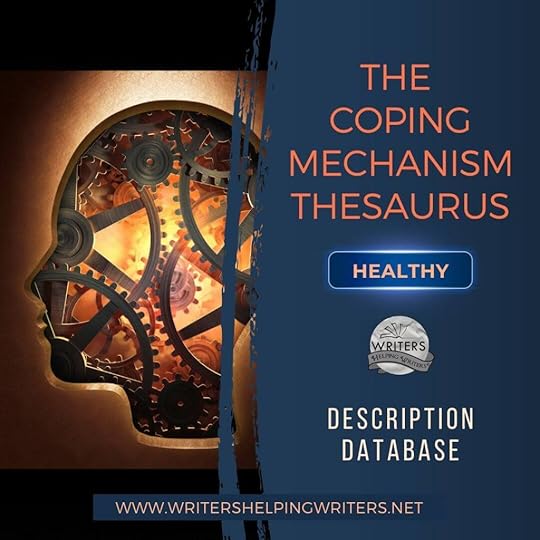
When a character suffers emotional pain, the brain���s response is to stop the discomfort, and often this results in a coping mechanism being deployed. Whether it’s an automatic response or a learned go-to strategy, a mechanism helps them cope with the stress of the moment or escape the hurt of it.
But if the character develops an unhealthy reliance on that mechanism, problems will arise. Long-term, certain coping behaviors will impair their connections with others, their ability to achieve goals and dreams, and their ability to handle life’s pressures.
At some point, they must have an Aha! moment where they realize their coping method is holding them back and seek other ways to deal with stress. Namely, they���ll have to adopt healthier mechanisms that enable them to manage difficulties and ultimately have a happier future.
To help you write your character’s growth (or regression) journey, we’ve created The Coping Mechanism Thesaurus, which contains a range of coping mechanisms. The one we’re highlighting today can help your character better manage painful emotions and stress. Use this partial entry to show readers the character is choosing more productive strategies that will build resilience.
Embracing Responsibility DefinitionEmbracing responsibility is all about accepting obligations and following through, even when it feels uncomfortable.
What It May Look LikePrioritizing what���s most important
Choosing needs over wants
Following through on commitments
Being proactive and planning ahead
Not making promises they can���t keep
Wanting to take responsibility but doubting their ability to succeed
Fearing they���ll only make a mess of things
Trying to stay personally accountable when others are not doing the same
Striving to do better but struggling to regulate emotions
Not wanting to fall into the trap of overcommitting, but also wanting to please or impress others
An unforeseen factor forcing them to default on an obligation or responsibility
Having to take a medication that increases impulsivity and decreases focus
Being measured against unreasonable or unfair expectations
Being sabotaged by someone who wants the character to fail
Being blamed for something that isn���t the character���s fault
Esteem and Recognition: Taking ownership of their obligations will not only lift the character in the eyes of others but will also build up self-worth.
Love and Connection: Becoming more responsible will show others that they’re dependable and committed, which can help resolve friction and strengthen relationships.

Need More Descriptive Help?
While this thesaurus is still being developed and expanded, the rest of our descriptive collection (18 unique thesauri and growing) is accessible through the One Stop for Writers THESAURUS database.
If you like, swing by and check out the video walkthrough for this site, then give our Free Trial a spin.
The post Coping Mechanism Thesaurus Entry: Embracing Responsibility appeared first on WRITERS HELPING WRITERS��.
October 7, 2025
Celebrating 10 Years at One Stop for Writers!
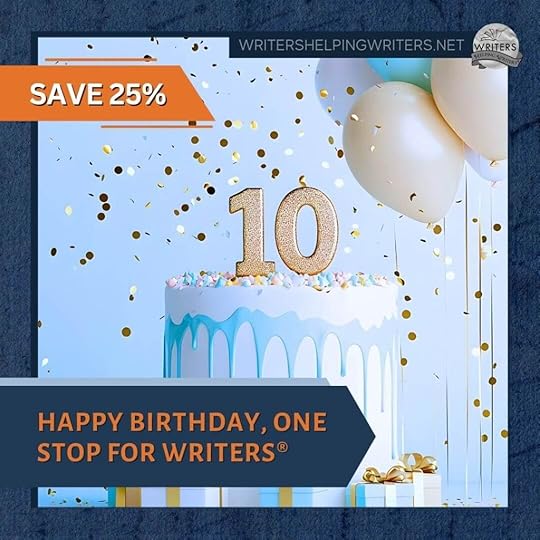
Happy Birthday, One Stop for Writers!
It’s hard to believe, but One Stop for Writers�� is officially TEN years old!
When Becca and I built One Stop for Writers with Lee (a software developer who also created Scrivener for Windows), all those years ago, it was a significant departure from books and blogging. But we were on a mission to make writing fiction easier for everyone–and we knew our tools would help do just that. Fast-forward to today, ten years in. We are grateful to writers everywhere for their trust in us and thrilled to be part of so many creative journeys!
Adding more tools over the years means One Stop for Writers has truly become one of the most comprehensive story support toolkits out there. From the world���s largest show-don���t-tell thesaurus database to planners, maps, and our beloved Character Builder, we���ve loved creating resources that have helped you get your stories onto the page for readers to enjoy.
Save 25% on all plans
To celebrate a decade of storytelling together, we���ve cooked up a special thank-you. Use the code below to save 25% on any subscription plan:
10YEARS
How to use this code:
Sign up or sign in at One Stop for Writers.Choose a plan (1-month, 6-month, or 12-month) and add this code: 10 YEARS to the coupon box.Once activated via the button, a one-time 25% discount will apply onscreen.Add your payment method, check the Terms box, and then hit subscribe!And that’s it. An arsenal of tools and resources is waiting to help you plan, write, and revise!
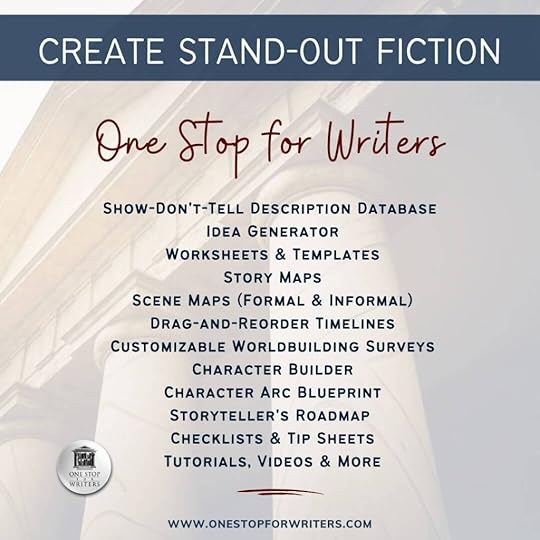
Redeem by October 16th, 2025.
New to One Stop for Writers?If you’re not familiar with One Stop for Writers, join Becca for a virtual tour. She’ll show you how using the right tools will help you write stronger fiction faster.
Looking to grow your writing skills? Show-don’t-tell like a pro. Our free 5-minute tutorials will help you activate the power of our descriptive thesauruses!Level up all of your stories. We share a ton of writerly gold in our free Tip Sheet & Checklist Database . Bookmark, share, and download.Snoop around the One Stop Library. Start a free trial–writing can be easier!Thank you for 10 great years! We’re honored to be part of your writing process and look forward to helping you write many more stories.
The post Celebrating 10 Years at One Stop for Writers! appeared first on WRITERS HELPING WRITERS��.
October 4, 2025
Coping Mechanism Thesaurus Entry: Self-Medicating
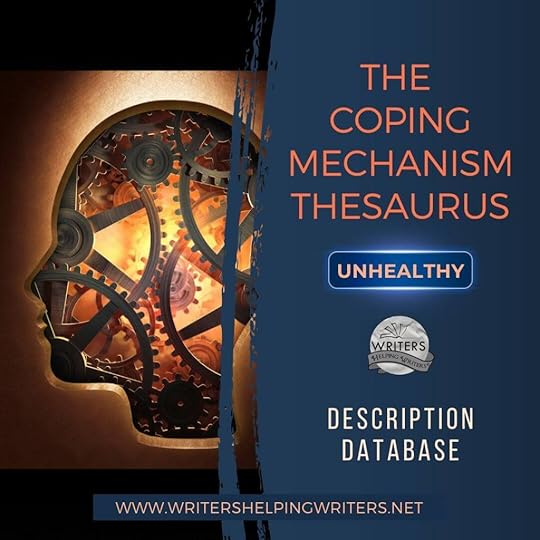
When a character suffers emotional pain, the brain���s response is to stop the discomfort, and often this results in a coping mechanism being deployed. Whether it’s an automatic response or a learned go-to strategy, a mechanism helps them cope with the stress of the moment or escape the hurt of it.
But if the character develops an unhealthy reliance on that mechanism, problems will arise. Long-term, certain coping behaviors will impair their connections with others, their ability to achieve goals and dreams, and their resiliency in handling life’s pressures.
At some point, they must have an Aha! moment where they realize their coping method is holding them back and they need to seek other ways to deal with stress. Namely, they���ll have to adopt healthier mechanisms that enable them to manage difficulties and ultimately have a happier future.
To help you write your character’s growth (or regression) journey, we’ve created The Coping Mechanism Thesaurus, which contains a range of coping methods. The one we’re highlighting today can be damaging, and we hope this entry will help you show your character’s struggle in a way readers can relate to.
Self-MedicatingDEFINITIONSelf-medicating is the use of substances or soothing behaviors to handle (or avoid) unwanted emotions, stress, and circumstances.
WHAT IT MAY LOOK LIKEUsing drugs, alcohol, cigarettes, food, shopping, gambling, sex, exercise, or other substances or activities specifically to numb physical or emotional pain
Medicating at the first sign of discomfort
Loosening the guardrails around usage (medicating at work where it is prohibited, for example)
Defensiveness when asked about the activity or usage
Always ���using��� after the same triggers (at bedtime, after fighting with a spouse, etc.)…
Love and Connection: Hiding a habit from loved ones, or prioritizing it over them, will create bad feelings in the character’s important relationships. Friction will also arise when friends and family are honest and confront the character about their concerns with the activity.
Safety and Security: In extreme cases, the character may sacrifice personal finances, healthy boundaries, and their physical or mental health to engage in their self-medicating activity…
Missing important family events
Becoming less productive or reliable at work
Finances becoming strained as the usage increases
Feeling isolated from others
The character���s physical health deteriorating…
Recognizing what triggers the need to self-medicate
Minimizing time spent with bad influences
Creating a plan for when the temptation to self-medicate is strong
Learning how to have difficult conversations rather than avoid them
Being accountable if a slip happens (rather than letting their progress be derailed by it)…

Need More Descriptive Help?
While this thesaurus is still being developed, the rest of our descriptive collection (18 unique thesauri and growing) is accessible through the One Stop for Writers THESAURUS database.
If you like, swing by and check out the video walkthrough for this site, then give our Free Trial a spin.
The post Coping Mechanism Thesaurus Entry: Self-Medicating appeared first on WRITERS HELPING WRITERS��.
October 2, 2025
What Kind of Writing Monster Is Lurking in Your Brain?
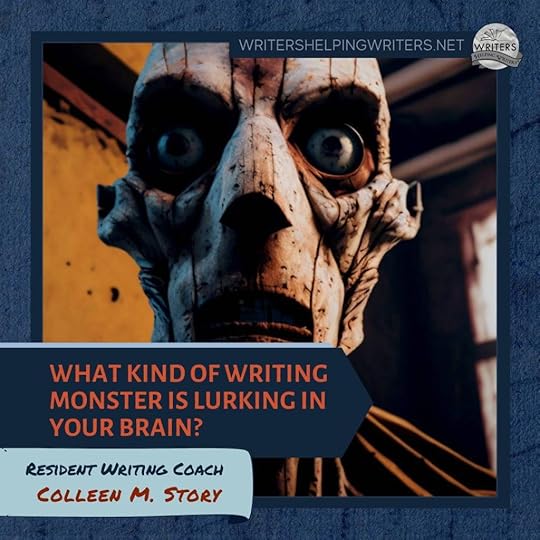
You wouldn���t think a productive writer would have to worry about monsters. But sometimes, just when you���ve cleared your schedule, opened your laptop, and promised yourself you���ll finally get that chapter (or email or video) done, something cold and invisible slinks up behind you.
Suddenly, you���re scrolling instead of writing, reorganizing your Scrivener folders, and researching branding fonts for the fifth time this week.
If that sounds familiar, here���s your diagnosis: There���s a monster in your brain.
Below, you���ll meet the four most common types that plague writers. These horrific beasts are drawn from the real patterns I���ve found in my research for my new book, Escape the Writer���s Web. Each monster represents a different conflict zone in your creative brain, and each comes with a set of tricks and a few treats to help you fight back.
Monster #1: The Whispering Wretch (a.k.a. The Inner Critic)You sit down to write or work on your marketing tasks, then find yourself endlessly editing, researching, or spiraling emotionally until you���re certain this manuscript needs to be dumped in the trash.
Meanwhile, your monster whispers things like:
���That���s not good enough.������Someone else already said it better.������Why even try?���How to Banish the Whispering WretchThis monster feeds on fear, especially fear of judgment, failure, or being seen. The goal isn���t to silence it entirely, but to shrink its power by creating safety, softening the stakes, and reducing the emotional load of showing up.
1. Lower the threat level.
The Wretch gets louder when the task feels too high-stakes, like everything hinges on this next sentence, pitch, or post. Your first move? Make what you���re tackling smaller and less ���important.���
Try this:
Write a deliberately awful paragraph just to prove the world won���t end.Rename your draft something absurd like UglyBlob_01.docx to trick your brain out of perfection mode.In marketing, post a ���throwaway��� caption in a secret document or alternate account where it doesn���t have to be polished or public.2. Break the shame spiral.
One of the Wretch���s favorite tricks is to require too much at once: write it, fix it, publish it, and defend it from judgment all in the first draft!
Try this:
First round: just ideas���no pressure.Second round: cleanup crew.Third round: polish and prep to share.When the critical voice pipes up early, say, ���This isn���t your shift yet. Come back at round three.���3. Build invisible momentum.
The Whispering Wretch thrives in stillness, particularly when you���re stuck, stalled, or staring too long at the blinking cursor. It withers when you start moving, even if the steps feel small or silly.
Try this:
Open your writing doc and type one sentence, any sentence. It doesn���t matter what it says. Then write one more.For marketing, try using a 5-minute timer to brainstorm headlines or hooks: no judgment or editing.Reward yourself for showing up, not finishing. Movement is the key measure here.Monster #2: The Ever-Hungry Howler (a.k.a. Energy-Momentum Disconnect)This monster gallops in at full speed, fangs bared, eyes wild, dripping ambition, and convinces you that now is the time to write the book, start the podcast, build the platform, update your website, grow an email list, and post three times a day on Instagram.
You feel possessed. Hyper-focused. Driven!
Until you crash. Then come the doubts, the guilt, and the scroll hole.
That���s how the Howler works: it fuels your drive until it devours your energy. The more you obey its manic rhythm, the louder it howls.
How to Banish the Ever-Hungry HowlerThis beast feeds on overcommitment and the shame that comes afterwards. The trick isn���t to work harder, but to work with your energy instead of always fighting it.
1. Create a minimum baseline.
When the Howler takes over, you believe every project matters equally, and that your success depends on doing all of it���right now.
To resist:
Choose one small keystone writing task each day (e.g., 15 minutes of drafting, one paragraph of revision).In marketing, define a single ���bare minimum��� action that keeps you visible without draining your soul. Maybe that���s scheduling one post per week or sending a once-a-month email that feels true to you.Declare your day ���done��� when that task is done. Anything else is a bonus.2. Build in recovery windows.
High creative energy is often followed by a natural lull. It would be nice if we could understand and honor that, but when haunted by the Howler, it���s impossible.
To outsmart it:
After intense writing days (or big visibility efforts like launches), pre-plan recovery time���a half day offline, a walk, a weekend away, or even just a change of scenery.Mark ���off-duty��� days in your calendar and protect them like deadlines.Let your audience or community know when you’re offline. This makes it harder for your brain to equate “not posting” with vanishing.3. Track your energy patterns, not just your progress.
We have to remember that our creative energy isn���t a machine. It���s more like a tide, and it needs to go out sometimes.
Try this:
Keep a simple journal or monthly calendar where you rate your energy on a scale of 1���5 and jot down what you worked on.Look for patterns. Are you more energized in the mornings? Mid-week? After certain types of tasks? At certain times of the month or year?Adjust your writing/marketing goals to sync with your high-output windows. Let the lows exist, remembering that they���re restorative.Monster #3: The Fogwalker (a.k.a. The Idea���Action Gap)
You���ve got ideas, so many ideas! An entire haunted library���s worth of outlines, snippets, and half-finished drafts. But when it���s time to pick one and take action, the fog rolls in. Everything feels overwhelming.
The Fogwalker doesn���t block you with fear or resistance. It just makes things too hazy to move.
How to Banish the FogwalkerThe trick is to simplify the path and reduce decision fatigue so you can move forward even when you���re not sure it���s the ���perfect��� move.
1. Limit your options.The Fogwalker grows stronger every time you stare at your ten open tabs or twelve half-outlined projects. To beat it, narrow the field.
Try this:
Choose one writing project to move forward with this month. Not forever, just for now.Pick one marketing channel to show up on consistently. Ignore the rest for 30 days.For creative ideas, make a ���Not Now��� doc. List other exciting options there, so you don���t feel like you���re losing them, but they don���t distract you either.2. Set micro-goals with visible wins.When every task feels too big or vague, your brain resists starting. Instead of ���revise chapter four��� or ���launch my Substack,��� break the fog into bite-sized chunks.
Try this:
Write one sentence. That���s it. Bonus points for a second.Create a single social post or newsletter draft���not a final version.Use sticky notes, checkboxes, or a visual tracker to see progress build. The Fogwalker hates evidence of momentum.3. Anchor your creative energy with structure.When your brain loves possibility, it rebels against rigid plans. But without some container, ideas stay floaty and the Fogwalker keeps you drifting.
Try this:
Use a weekly rhythm instead of a daily schedule. Example: Mondays = content planning, Tuesdays = drafting, Fridays = send/share.Give each idea a time limit: ���I���ll explore this story concept for 30 minutes, then decide next steps.���For marketing, try a repeatable format (e.g., a weekly ���tip Tuesday��� post or monthly ���writer behind the scenes��� email) to reduce the need for new decisions every time.Monster #4: The Rebel Revenant (a.k.a. The Autonomy Tension Trap)You meant to work on your novel or follow through on the launch plan you swore you’d stick to this time, but then you got this weird urge to do literally anything else. Suddenly, folding laundry felt like freedom.
That���s the Rebel Revenant. He shows up with defiance when a task feels imposed, forced, or loaded with expectation, or as the fun-seeker who wants novelty, dopamine, and creative freedom.
How to Banish the Rebel RevenantThis monster feeds on anything that feels like it���s boring or like you ���should��� do it. The trick isn���t to push harder, but to reframe the task so it feels like a fun choice, not a drab command.
1. Make it yours.To reclaim your creative fire, you need to feel like you���re driving instead of being dragged.
Try this:
Reword your to-dos in your own voice. Instead of ���Outline chapter three,��� try ���Play with what happens next.���For marketing, stop copying someone else���s formula. Create your own version of visibility. Hate video? Try audio. Hate social media? Focus on email or collaborations.Ask yourself: ���If I were doing this my way, what would that look like?���2. Add play���or a tiny rebellion.If it feels too serious or structured, you���ll ghost it. So bend the rules. Add a twist.
Try this:
Set a kitchen timer and race yourself. Write one messy paragraph before it dings.For marketing, post something honest, weird, or wildly off-brand just to see what happens.Give yourself one ���free pass��� day per week with no guilt. When you know you���re allowed to skip, you’re less likely to do so.3. Create goals that leave room to roam.Rigid checklists make the Rebel Revenant cranky. You need structure, but with wiggle room.
Try this:
Set flexible outcome-based goals. Instead of ���write every day,��� try ���finish two scenes this week.���Pick from a menu of tasks: ���Today I���ll do one of these five things.��� (Not all, just one.)For marketing, build in spontaneity. Have a list of quick ���fun��� posts or ideas you can draw from when the mood strikes.What���s Your Monster?I created a free quiz to help you identify which monster has been haunting you (in non-Halloween language). It takes just a few minutes, and the results will give you real insight into why you keep stalling out.
Go on. Shine a flashlight into the dark corners of your writing brain. What you find might finally set you free.
The post What Kind of Writing Monster Is Lurking in Your Brain? appeared first on WRITERS HELPING WRITERS��.
September 30, 2025
Meet Our 2025 – 2026 Resident Writing Coaches
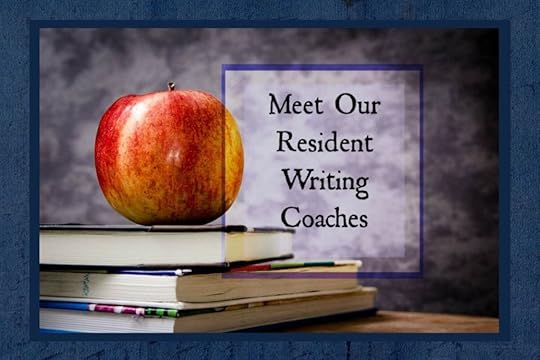
I love being the Writers Helping Writers Blog Wizard���and am honored to work closely with the Resident Writing Coaches. They���re all talented, generous authors who share their wisdom to help take your writing to the next level. I’ve learned so much from them, and have a feeling you have, too!
This is the 10th year of our popular Resident Writing Coach program where we feature writing experts through a series of four blog posts scattered throughout the year. We bring in a mix of expertise, so you benefit from different voices and perspectives from all over the world.
Each year we have some new coaches and some returning, so let me first say goodbye to the wonderful Marissa Graff and Christina Delay. We greatly appreciate all they have shared with us. I’m thrilled that Marissa will be our guest editor for several upcoming critique contests, and hope she and Christina will be back as coaches in the future.
I���m excited to welcome two amazing Resident Writing Coaches. Please give a warm welcome to���
Jill Boehme was known for many years to the online writing community as Authoress, hostess of Miss Snark���s First Victim, a now-retired blog. She is the author of Stormrise and The Stolen Kingdom; she is also a writing coach, a freelance editor, and a staunch defender of the Oxford comma.
You will also find Jill teaching writing classes both locally and online. She finds great joy in encouraging and inspiring writers.

Julie Artz helps status quo busting writers slay their doubt demons and get their stories reader-ready. She is an Author Accelerator-certified Founding Book Coach and a sought-after writing instructor and speaker. She regularly contributes to Jane Friedman and Writers Helping Writers, and is an instructor for AuthorsPublish. A consummate social justice minded story geek, Julie lives by an enchanted river in Fort Collins, Colorado with her husband, two naughty furry familiars, and two college-aged children who occasionally manifest.
You can find her on Youtube and Substack.��
Is Your Story Reader-Ready? Take the quiz to find out.
In addition to our new coaches, we���re thrilled to have these returning masterminds���
Lucy V. Hay is a UK-based script editor & reader, and creator of the popular site, Bang2Write, a top screenwriting blog topping industry lists such as Writer���s Digest���s 101 Best Websites for Writers. She���s edited UK features and shorts for 20+ years and authored the bestselling Writing & Selling Thriller Screenplays. Her alter-ego, Lizzie Fry, pens dark thrillers including her latest, The Good Mother. You can find Lucy at her thriving Bang2Write community, helping writers improve their craft through insightful, real-world advice.

Colleen M. Story writes award-winning historical fantasy, supernatural thrillers, and motivational books for writers. Her latest, Escape the Writer���s Web, reveals a breakthrough method for overcoming procrastination. On YouTube, she helps writers stay motivated, focused, and creatively aligned, and through MasterWriterMindset.com, offers immersive workshops and unconventional tools for stuck writers. A freelance health writer, Colleen also speaks at writing conferences across North America. Find all her books at ColleenMStory.com.

Jami Gold is an award-winning paranormal romance author and blogger whose site was recognized by Writer���s Digest as a 101 Best Website for Writers. Her massive collection of resources for writers include popular worksheets (including the Romance Beat Sheet), workshops, and over 1000 posts on her blog. Jami is known for her deep dives into all aspects of craft, business, and life of writing and has helped tens of thousands of writers over the years.

Lisa Poisso is a book coach, editor, and writer with a background in journalism, communications, and magazine publishing. She specializes in working with new and emerging writers to create commercial fiction with emotional resonance. Her structured, artistry-meets-craft approach draws on her early training in classical dance. Lisa curates the popular Writes of Fiction newsletter and coaches alongside her pack of #45mphcouchpotato greyhounds.
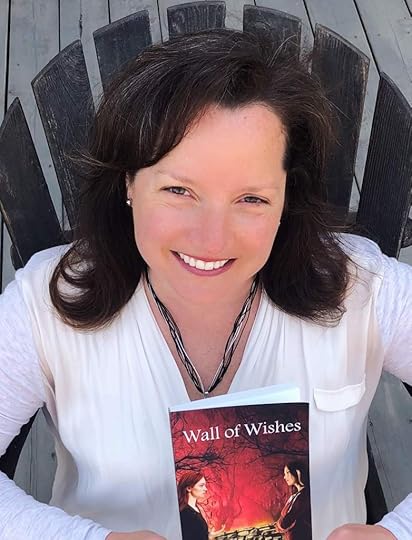
Suzy Vadori is the award-winning author of The Fountain Series, a certified book coach with Author Accelerator, and founder of Wicked Good Fiction Bootcamp. She works with writers new to the industry, offering developmental editing, coaching, and online courses. Her superpower is tirelessly working to simplify complex craft topics to get writers up to speed and motivating them to reach their full potential.

Michelle Barker is an award-winning author, editor, and writing teacher based in Vancouver, Canada. Her novel, The House of One Thousand Eyes, won numerous awards and was named a Kirkus Best Book of the Year. She���s also co-authored Story Skeleton: The Classics and Immersion and Emotion: The Two Pillars of Storytelling with David Griffin Brown. Michelle loves working closely with writers to hone their manuscripts as a senior editor at The Darling Axe.

Jenny Hansen is a copywriter, brand storyteller, and LinkedIn coach by day, and a writer at night, working on memoir, humor, and women���s fiction. She���s a co-founder of Writers in the Storm, a long-running craft blog named to Writer���s Digest���s 101 Best Websites list. Jenny���s writing is known for a blend of heart and wit and she���s currently revising a memoir based on her cancer journey.
Tip: Love a post? Click on the name up top to see all the posts from that person.
Here���s to another year of amazing posts. Please give a warm welcome our Resident Writing Coaches.
Pssst���when you comment on their posts, they reply to you! So please share your thoughts and ask questions throughout the year. Angela, Becca and I love working with the coaches. They���re an incredible asset to the Writers Helping Writers blog.
If there���s a topic you���d like help with, please add it in the comments so hopefully one of our Resident Writing Coaches will post about it.The post Meet Our 2025 – 2026 Resident Writing Coaches appeared first on WRITERS HELPING WRITERS��.
September 27, 2025
The Coping Mechanism Thesaurus is Coming!
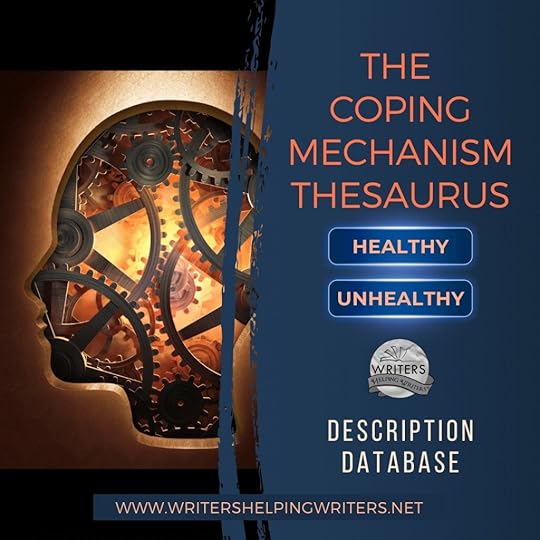
Characters don���t always react to stress and threats in healthy ways–like real people, they lean on coping strategies they���ve developed to survive past trauma and avoid new pain. These dysfunctional coping mechanisms consist of behaviors and thought patterns designed to keep discomfort at bay. But habits formed in the past can become obstacles in the present.
Unhealthy mechanisms are forms of emotional shielding meant to protect the character from harm���specifically, from the recurrence of a past wounding event. And many times, they do keep those traumas from repeating. But they also create new difficulties. Practices like denial, avoidance, overindulgence, and self-sabotage generate issues that reverberate through their relationships, work performance, personal satisfaction, and the pursuit of their story goal.
Over the course of a story, the character must become aware of their go-to mechanism, realize how it���s holding them back, and replace it with healthy coping methods that will get them where they want to go. In this way, coping methods will play a key role in your character���s arc.
To help you write a transformation journey that���s authentic and complete, we���re launching The Coping Mechanism Thesaurus. Each Saturday, we���ll share a coping method that���s common to the human experience and could play into your character���s story. Here���s a sneak peek at what each entry will include.
What the Mechanism Looks LikeCoping behaviors show up in all kinds of ways���through speech, body language, habits, and emotional reactions. The content in this field will include a variety or fight, flight, and freeze responses associated with this mechanism. Showing these responses in believable ways builds realism and gives readers insight into what���s going on with the character under the surface.
Basic Human NeedsCoping mechanisms are tightly linked to a core element of character arc: basic human needs. Unhealthy mechanisms rob the character of a vital need, creating a void that they���ll go to great (and dysfunctional) lengths to fill. On the flip side, healthy mechanisms refill the hole. Knowing what mechanism will need to be replaced is the key to helping your character regain balance and learn positive methods that will help them achieve their goals and face difficulties in productive ways.
Fallout (And Possible Turning Points)Many unhealthy coping mechanisms start out as a benign behavior or attitude. They only become a problem when the character takes them to an extreme, can no longer function without them, and continues relying on them despite the damage they cause. The Fallout field is meant to show authors the many ways a coping method wreaks havoc. Then they can incorporate it into the character���s life so they���ll eventually see the need for change.
Challenges That Will Test the CharacterGrowth doesn���t happen immediately. Once a character realizes their current methods aren���t working for them, they���ll try a different one. But old habits die hard, and regression is a normal part of any transformation journey. Each healthy coping mechanism comes with its own challenges that can tempt the character to throw in the towel and revert to what���s comfortable. Likewise, certain internal struggles will make it harder for them to stick with the program long enough to effect change and see the benefits of coping in positive ways.
Pathways to Changing Unhealthy MechanismsTo complete a personal transformation, the character will need to discard their half-hearted attempts and fully commit themselves to change. By the story���s end, they���ll have embraced some mental shifts and new habits to show they���ve gone all in and are committed to the long-term work of healing. This field gives writers options for what true commitment to unloading the unhealthy mechanism looks like.
Final ThoughtsThe Coping Mechanism Thesaurus is designed to help you write both healthy and unhealthy methods with depth and nuance. We hope the entries we share will give you the tools to chart your character���s path to change and wholeness.
Frequently Asked QuestionsWhere Can I Buy This Book?Unfortunately, the Character Secret Thesaurus isn���t a book yet. When we introduce a new thesaurus on the blog, it means we���ve only started writing it. Our process is to ���test��� each new thesaurus here at Writers Helping Writers by posting a new entry each Saturday. If, over time, we receive feedback that writers find the thesaurus helpful and would like to see it become a book, we mark it as a possible book project for the future
Can I do something to ensurethis thesaurus becomes a book?
Yes! Take a minute to leave a comment on any of our Character Secret posts saying this topic will help you so we know! Another huge way to muster support for this thesaurus is to share links to it on social media or in writers��� groups so others know help is available in this area. The resulting boost in traffic here tells us the thesaurus is a popular one. (Thank you for doing this���we appreciate word of mouth!)
Will the book version be the same as the blog version?What you see here on the blog is only a fraction of what you���d see in a book, for a few reasons:
We only explore some secrets here, whereas the book will have many, many moreWe���re a huge target of AI scraping, which forces us to limit the content we share freely here.Each book also includes an expansive ���how-to��� section that explores how to use the thesaurus topic in a story more effectively. Our biggest mission is to help writers grow their craft, because great stories get noticed!How can I stay in the loop when you release a new book?We have an email list you can sign up for. We���ll send a note when a release date is coming, and then again when the book is available. (Thank you for asking!)
Is this Thesaurus at One Stop for Writers?Not just yet. We always wait until we have many thesaurus entries written before we add them to our show-don���t-tell database there. In the meantime, the One Stop THESAURUS is worth checking out since it contains all the thesauruses we���ve created to date (18) vs. how many exist in book form (10).
Is there a question I didn���t answer? Just leave it in the comments!
The post The Coping Mechanism Thesaurus is Coming! appeared first on WRITERS HELPING WRITERS��.
September 25, 2025
Writing 101: How to Find & Write Your Character���s Voice
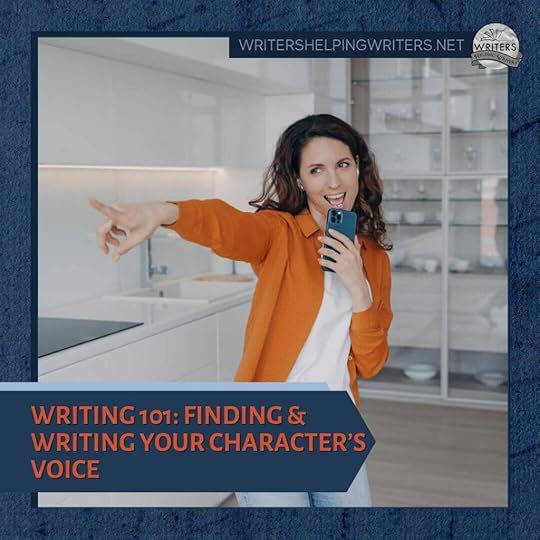
Writing a strong and consistent character voice is one of the best ways to make your story stand out. A unique voice tailored to your character makes them feel real and more memorable to readers.
But voice is tricky to get right. Too little attention to this important aspect of storytelling results in all the author���s stories sounding the same because they���re written in their voice. And the characters fade into the background. A well-written voice, on the other hand, reflects personality, background, worldview, and emotional state, among other things. Together, they combine to create an individual voice that fits them perfectly.
Angela and I know how hard it is to nail the character���s voice, so we���ve curated quite a few posts at Writers Helping Writers on this topic. Rather than rehash what���s already been shared so well, I thought I���d gather some of those resources here, for easy reference. Hopefully these strategies will help you uncover your character���s voice and write it in such a way that readers will be hearing it long after the story is finished.
Character Voice vs. Author VoiceIt���s easy when you���re writing a story to tell it in your own authorial voice. But the voice should reflect whoever���s narrating the story, showing their view of the world. Understanding the key differences between character voice and authorial voice will help you stay in your character���s mindset. This is especially important when you���re writing in a close point of view.
Interview Your CharacterTo know how your character sounds, you have to know who they are. Interviewing a character���asking them detailed, open-ended questions���can reveal their emotional patterns, values, beliefs, and opinions. These insights reveal the lens through which they experience the world, and once you get a feel for that, their voice is easier to write.
(Read the post)
Know How They TalkThis is what comes to mind when we think of a character���s voice���their word choice, speed and cadence, patterns,and tone. How their speech sounds is a result of where they���ve lived, their education, and (again) their personality. More than just accents or slang, it���s about capturing the nuance of how they talk. Giving each character a clearly defined way of speaking makes them uniquely individual and provides readers with clues to who they are.
(Read the post)
Use Body Language to Show VoiceWhen it comes to voice, we typically think of speech and how the person talks. But that���s just part of the picture. Body language is a pivotal piece of how the character expresses themselves, and it���s dictated by their personality, emotional range, and comfort level with others. When you can show their body language, tendencies you���ve provided another piece of the voice puzzle.
Understand Their Internal WorldYour narrator���s inner dialogue���what they think and how they think it���will be played out on the pages as they tell the story. This key part of their voice will reveal their emotional makeup, self-talk, coping habits, worldview, and problem-solving behaviors. It also provides insight into how they process the people and challenges they���ll encounter.
Your narrator���s voice should be revealing, providing clues to their backstory and character. Once you determine their speech patterns, how they move, their most formative experiences, and what���s important to them���the voice tends to write itself. At that point, it���s just a matter of writing it consistently to make the character believable and interesting to readers.
For more help writing character voice and understanding other key aspects of storytelling, visit our Other Story Elements page.
Other Posts in This Series
Dialogue Mechanics
Effective Dialogue Techniques
Semi-Colons and Other Tricky Punctuation Marks
Show-Don���t-Tell, Part 1
Show-Don���t-Tell, Part 2
Infodumps
Point of View Basics
Choosing the Right Details
Avoiding Purple Prose
Character Arc in a Nutshell
The post Writing 101: How to Find & Write Your Character���s Voice appeared first on WRITERS HELPING WRITERS��.
September 23, 2025
How to Use Weather to Create Mood, Not Clich��s
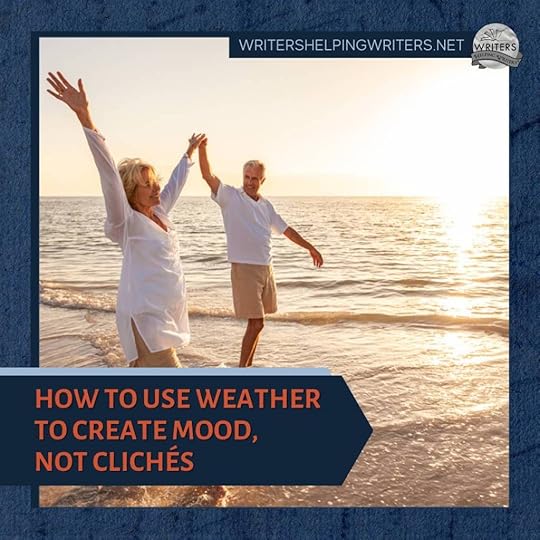
Are you afraid of using the weather in your writing? If so, you’re not alone. After all, if not careful, weather description can be a minefield of clich��s. The sunny, cloudless afternoon at the beach. The gloomy rainstorm at a funeral. Overdone setting and weather pairings can lie flat on the page.
Then there’s the danger that comes with using weather to mirror a character���s inner emotional landscape. Mishandling this technique can quickly create melodrama. We’ve all read a battle scene where lightning crackles as our protagonist leaps forward to hack down his foe in desperation. And how about that turbulent teen breakup where the character’s tears mix with falling rain? Unfortunately these have been used so much that most readers tilt their head and think, Really? when they read a description like this.
Agents and editors on first page panels never fail to reject a few openings that start with the weather, either. Why? Because done poorly, it comes across like a weather report, and delays the introduction of the hero. Readers are not always patient and we should strive to introduce our characters and what they are up against as soon as possible.
Wow, weather sounds like a recipe for disaster, doesn’t it? It���s no wonder that some writers are so nervous about using it they cut it from their manuscript. But here���s the thing���avoiding weather in fiction can be a fatal mistake.
Make Weather Your FriendWeather is rich. Powerful. It is infused with symbolism and meaning. And most of all, weather is important to us as people. We interact with it each day. It affects us in many subtle ways. In fact, let���s test this by walking in a character���s shoes.
Think about walking down a street. It���s late afternoon, crystal bright, and a hot breeze blows against you. School���s out and kids run willy-nilly down the sidewalk, laughter ringing the air as they race to the corner store for a grape slush. Your sandals click against the pavement as you turn down between two brick buildings. The side door to an Italian restaurant is just past a rusty dumpster, and your fianc��e���s shift is about to end. You smile, feeling light. You can���t wait to see him.
Now, let���s change the scene.
It���s sunset, and the weather has soured. Dark clouds pack the sky, creating a churning knot of cement above you. The sidewalk is deserted, and the wind is edged in cold, slapping your dress against your legs as you walk. You wish you���d worn pants, wish you���d brought a sweater. In the alley, garbage scrapes against the greasy pavement and the restaurant���s dumpster has been swallowed by thick shadow. The side door is only a few steps away. You can���t quite see it, and while all you have to do is cross the distance and knock, you hesitate, eyeing the darkness.
The same setting, the same event. Yet, the mood and tone shifted, all because of the weather I included in the backdrop. What was safe and bright and clean became dark and alien. This the power of weather–changing how people feel about their surroundings.
Steering Your Reader’s EmotionsReaders bring the real world with them when they enter a story. Avoiding weather description will be noticed as it’s such a natural part of the everyday, and it becomes a missed opportunity to steer how our readers feel.
Weather is a tool to evoke mood, guiding the character toward the emotions we want them to feel, and by extension, the reader as well. By tuning into specific weather conditions, a character may feel safe, or off balance. Weather can work for or against the character, creating conflict, tension, and be used to foreshadow, hinting that something is about to happen.
Because we have all experienced different types of weather ourselves, when we read about it within a scene, it reminds us of our own past, and the emotions we felt at the time. So, not only does weather add a large element of mood to the setting, it also encourages readers to identify with the character���s experience on a personal level.
How Do We Write Weather in a Clear Way and Stay Away From Pitfalls?Use Fresh, Sensory Images. In each passage, I utilized several senses to describe the effects of the weather. A hot breeze. Garbage scraping against the greasy pavement. A wind edged in cold, slapping against the legs. By describing weather by sound, touch and sight, I was able to make the scene feel real.
Avoid Direct Emotion-to-Weather Clich��s. There are some pairings we should avoid as I mentioned above, and with so many different types of weather elements we really need to think past the usual ones. Avoid mirroring and instead show the character���s reaction to the weather. This is a stronger way to indicate their emotions without being too direct.
Choose Each Setting with Care. Setting and Weather should work together, either through contrast or comparison. In the first scene, we have beautiful weather and an alley as a final destination. These two are contrasts���one desirable, one not, but I chose to show enthusiasm and anticipation for the meeting to win out. In the second, the weather becomes a storm. Now we have two undesirable elements, and as such, they work together to build unease.
Weather can have a positive or negative effect on setting and change the character���s reaction to it, so don���t be afraid to use it! Just remember that with something this powerful, a light touch is all that is needed.
Would you like help brainstorming descriptions for different types of weather?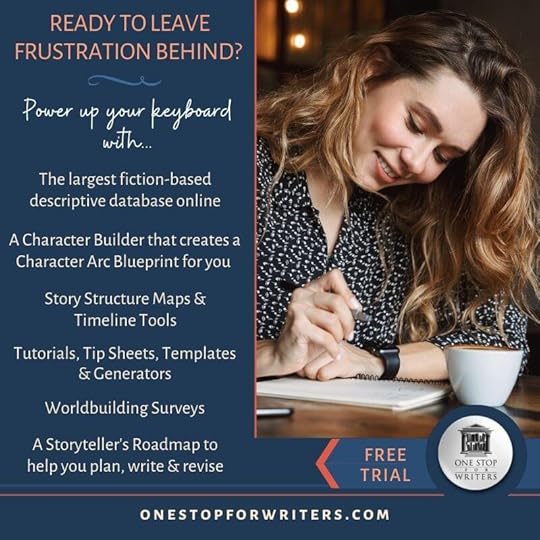
Check out our comprehensive Weather Thesaurus at One Stop for Writers. There you can access all sorts of weather phenomenon, and the sights, smells, sounds, tastes and textures that will help you show, not tell, building in the exact emotional mood you want for each scene.
Great news! Check out this post to get 25% off any One Stop for Writers plan through September 25, 2025!
How do you use weather in your stories?The post How to Use Weather to Create Mood, Not Clich��s appeared first on WRITERS HELPING WRITERS��.
Writers Helping Writers
- Angela Ackerman's profile
- 1016 followers



